We’ve heard it for years: the Toronto Maple Leafs need defence; they need to bring in better defencemen and commit to playing better defensively as a team. For a while, the sentiment was accurate: the team sacrificed defensive responsibility to score goals. This season, though, we’ve seen a major shift and defense isn’t the main issue. Somehow, the star-studded squad simply can’t score.
What’s wrong with the Maple Leafs’ offence, and more importantly, how can they fix it?
The Maple Leafs Aren’t Scoring
It’s crazy, right?
A team led by Auston Matthews (the best 5-on-5 goal scorer of this generation), John Tavares, Mitch Marner, William Nylander, and Morgan Rielly is struggling to score goals.
After 19 games – nearly a quarter of the season – the Maple Leafs are 12th with 2.69 goals for per hour at 5-on-5. Thanks to their anemic power play, that number isn’t much better at all strengths, improving to just 11th overall (3.24 goals per hour). Simply put, it’s a mediocre offence.
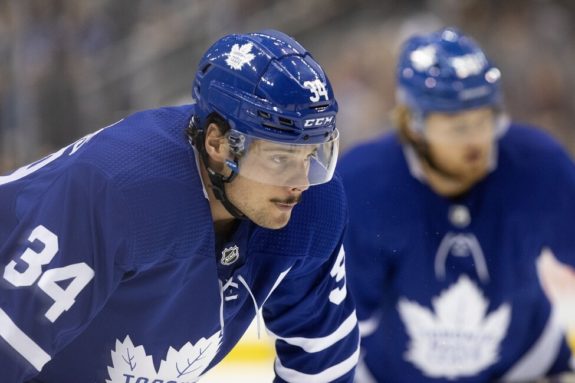
Yet, this is the same team that was fourth in scoring last season with 286 goals – nearly 3.5 per game. This is the team that, over the last three seasons, scored 806 goals, behind only the dynastic Pittsburgh Penguins and the high-flying Tampa Bay Lightning.
What gives? Did the replacement of Nazem Kadri with Alexander Kerfoot hurt the offence that badly? I don’t think so, given that Kadri has just one goal and four points more than his successor so far. Besides, the additions of players like Ilya Mikheyev and Tyson Barrie were supposed to make up the difference of any losses, and more.
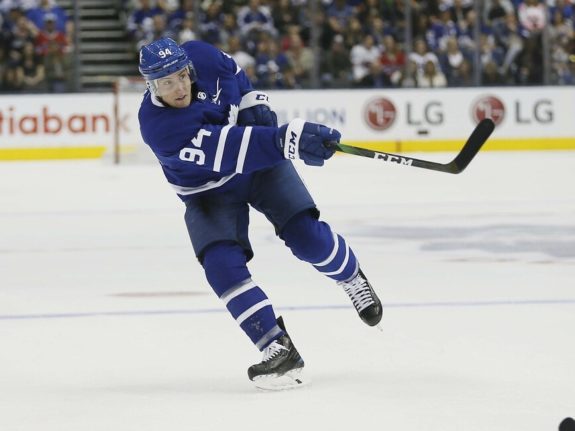
Before the season, almost everyone would have predicted an even more dangerous offensive team than what we saw in seasons past. Replacing defence-first players like Ron Hainsey and Connor Brown was supposed to aid in the creation of a puck-moving, run-and-gun juggernaut. On paper it sounded good. On the ice it’s looked terrible.
Why is that the case? There’s more to it than personnel. Let’s dig deeper.
Maple Leafs Are Shooting, Not Generating Chances
There are two ways to score goals – two philosophies, if you will. The first is through volume – quantity; pucks on net, as the old mantra goes. The second is by generating good looks from high-danger areas close to the net. Good teams do both.
In years past, the Maple Leafs were elite at both. Looking at all strengths from 2016-17 to 2018-19, Toronto ranked third in shot attempts per hour (61.76), first in scoring chances per hour (31.98), and third in expected goals for per hour (2.95). They took a lot of shots, generated a lot of chances, and in turn scored a lot of goals.
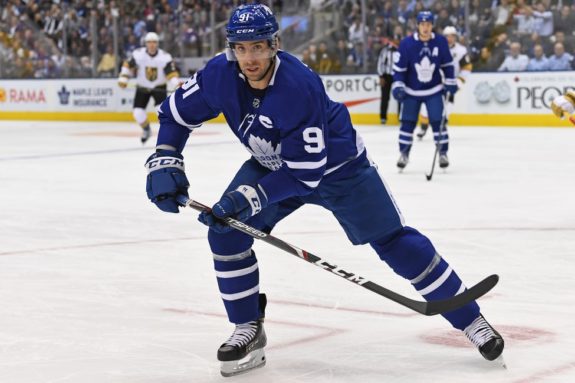
This season, things have changed. While the Maple Leafs are still generating shot attempts at an elite rate, ranking second in the league with 62 attempts per hour at 5-on-5, they’re simply not getting enough quality looks. They’ve fallen to ninth in scoring chances per hour (24.42) and all the way to 23rd in high-danger chances per hour (9.49). That’s uncharacteristic for a team with so much talent and a history of success.
If a visual reference helps, take a look at this:
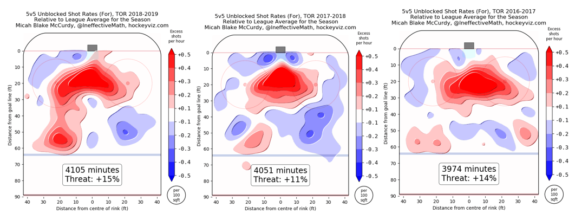
Here are the Maple Leafs’ 5-on-5 unblocked shot charts from the past three seasons. You should notice a couple of clear patterns. First, there’s a consistent big red blob in front of the opposing net, indicating and confirming that the Maple Leafs generated a lot of shots from dangerous areas. Second, the threat level is extremely high (ranging from plus-11 to plus-15 percent), illustrating that they’ve been well above league average in terms of shots and chances.
Now, let’s compare that to this season.
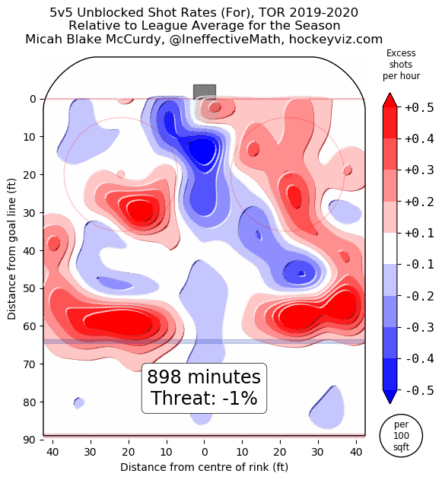
If your first reaction to the chart was, “yikes,” then your interpretation is correct. Abandoning the strategy of shooting from the slot, the bulk of the Maple Leafs’ shots this season have come from either side of the blue line and the tops of the circles – not exactly prime scoring areas. In fact, the blue line is probably the worst place to shoot the puck from, given the distance and low probability of scoring.
Lots of things have changed behind the scenes in Toronto, but I think there are some clues about what’s driving this seemingly systematic change.
The Hakstol Effect
If you read my article from earlier this week, you’ve already heard about “The Hakstol Effect.”
The theory is that the Maple Leafs’ new assistant coach, Dave Hakstol, has an inexplicable penchant for making his defencemen take as many point shots as possible. I’ve heard the theory proposed by Maple Leafs fans, Philadelphia Flyers fans, and neutral fans. When we look at the facts, the findings are telling.
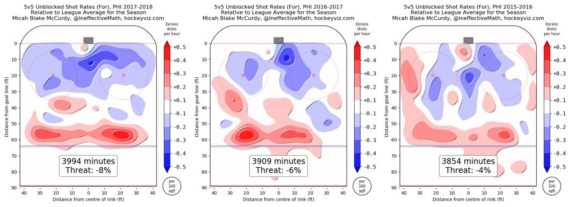
Does this look familiar? It should, because it’s eerily similar to the Maple Leafs’ 2019-20 shot map above. From 2015 to 2018, with Hakstol as the head coach, the Flyers relied mostly on point shots as their source of offence. That probably explains why they were a middling offensive team, ranking 17th in goals scored over that span.
Fast forward to this season, and the Flyers’ offence sans Hakstol looks like it’s getting back on track.
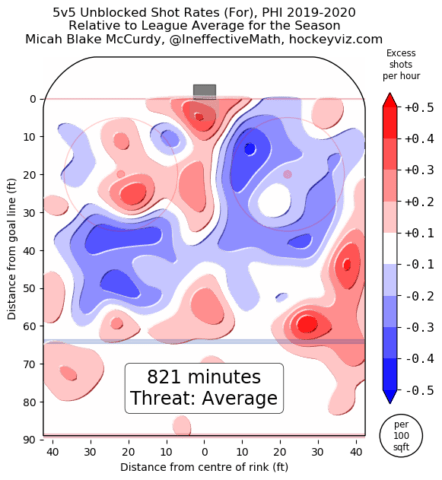
Yes, the Flyers are just league average in terms of chance generation, but that’s a marked improvement over Hakstol’s teams. While they still employ some point shots, the Flyers are clearly getting to the net a lot more now.
The implication is that Hakstol is having a significant impact on the Maple Leafs’ offence, or lack thereof. It’s hard to believe that a coach as strong-willed as Babcock would be swayed by an assistant’s wishes, but that appears to be a major factor here.
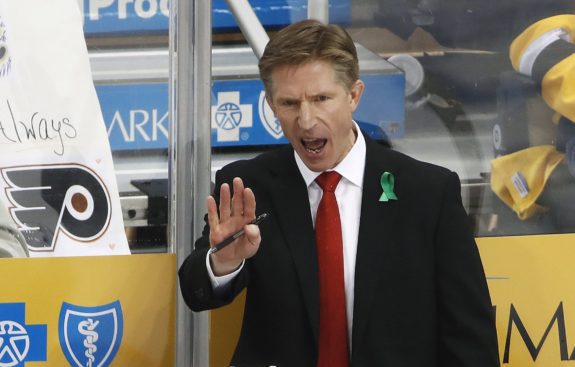
Can the Maple Leafs fix their struggling offence?
Of course they can. The team’s top offensive players are the same as last season and under Babcock the Maple Leafs have a history of being elite offensively. All they have to do, in theory, is go back to what worked before: shoot less from the point and get to the net. It’s an issue of mindset and tactics rather than talent. On paper, it should be relatively easy.
What the Maple Leafs are learning this season is that paper doesn’t always translate so easily to the ice.
Stats from Hockey-Reference and Natural Stat Trick